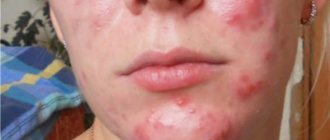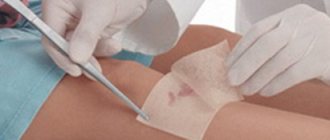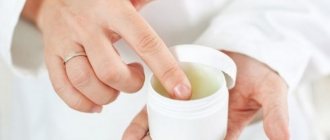A boil on the face is an unpleasant phenomenon not only from an aesthetic point of view. Purulent abscesses cause pain, require careful treatment and sometimes have dangerous consequences.
Boils are the result of the harmful action of pathogenic microflora , mainly Staphylococcus aureus. The bacterium infects the hair follicle, nearby sebaceous glands and neighboring tissues.
The boil usually has a cone-shaped shape; in the middle of this formation there is a purulent-necrotic rod.
In the International Classification of Diseases, skin abscess, boil and carbuncle of the face are designated by the coding L02.0. Purulent lesions of the neck have their own ICD-10 code – L02.1.
A scalp boil (along with an abscess and carbuncle) is designated by code L02.8.
Causes and risk factors
A healthy body is able to fight pathogenic microflora, but a decrease in its protective functions can lead to the development of inflammatory processes.
One of the main reasons for the formation of boils is weak immunity due to:
- chronic diseases;
- not fully cured infections;
- dysfunctions of the endocrine system;
- long-term use of antibiotics, hormonal agents, and drugs that suppress the immune system.
A weakened body is not able to resist the harmful effects of Staphylococcus aureus - it is this bacterium that mainly provokes the appearance of boils on the face and head.
Less commonly, the causative agents are other pathogens - white staphylococcus, streptococci of groups A and B.
There are a number of other reasons why purulent abscesses form in the maxillofacial area:
- skin pathologies – acne, pimples, fungal infections, eczema, atopic dermatitis;
- severe sweating, increased sebum secretion;
- poor hygiene – the pores of insufficiently cleansed skin become clogged with fat and dirt;
- damage to the skin - cuts, abrasions, scratches, burns; in men, microtraumas often occur due to careless shaving;
- skin contamination due to harmful working conditions - dust, contact with chemicals;
- squeezing pimples, which causes infection under the skin;
- hormonal imbalances - often in adolescence, during pregnancy and menopause;
- the presence of bad habits, especially addiction to alcohol, poor nutrition;
- stress and overwork.
The disease occurs more often in children than in adults for a number of reasons:
- children are not yet accustomed to observing the rules of personal hygiene; they spread infection with unwashed hands;
- with atopic dermatitis or other manifestations of allergies, children cannot tolerate itching and scratch the skin, injuring it; Read about the features of atopic dermatitis in children in this material;
- A child has a special skin structure - a network of capillaries is developed in the thin stratum corneum, bacteria easily spread through the bloodstream throughout the body.
Reasons for appearance
Boils are formed due to infection entering the body, which disrupts the microflora of the skin. Any scratch or dirty towel causes infection.
Associated negative factors:
- Colds.
- Low immunity.
- Avitaminosis.
- Hormonal disbalance.
- Stressful situations.
- Disruption of the sebaceous glands.
By the way, this problem can also occur in a healthy person.
Symptoms of an abscess
How can you understand that it’s not just a simple pimple that has popped up on your skin, but a purulent abscess – a boil?
What characteristic symptoms signal this problem, which is especially unpleasant when localized on the face and head in the hair:
- the skin at the site of inflammation turns red and becomes hot to the touch;
- the affected area is dense, swelling occurs around it;
- the sore spot makes itself felt by itching, tingling, pulsation;
- the cone-shaped seal quickly increases in size and causes pain;
- the development of a boil is accompanied by fever, headaches, enlarged lymph nodes, weakness, and sometimes fever.
If such symptoms appear, you should seek help from a doctor, since treating ulcers on the face at home is dangerous due to complications.
It is imperative to visit a doctor if several boils form on your face, close to each other.
This is a sign of the development of a carbuncle, which without proper treatment can provoke infection into the bloodstream. Find out what a carbuncle is, its causes and treatment methods here.
The main causes, treatment methods and photos of cheilitis on the lips are presented in this article.
You can learn about how streptoderma begins in children (with photos) from our publication.
Instructions for using Lokoid cream are discussed here: https://udermatologa.com/prep/kortik/krem-i-maz-lokoid-pokazaniya-instruktsiya-po-primeneniyu-otzyvy/
Localization of the abscess on the head
Boils often form on the face and scalp, since a large number of sebaceous and sweat glands and hair follicles are concentrated in these places. Pathogenic bacteria penetrating there cause the development of subcutaneous purulent processes.
Let's look at the most common places where boils are localized. We talked about the symptoms and methods of treating a boil in the ear in this article.
Neck
A boil on the neck is dangerous because infection in the blood vessels located here can lead to brain damage - purulent meningitis. It is also possible to develop a neck abscess.
The appearance of a boil in this area is provoked by constant pollution (sweat and fat, dust particles from the environment) and insufficient hygiene.
The neck can also be easily injured from constant contact with the collar of clothing. This allows bacteria to easily penetrate microcracks.
Their reproduction inside the hair follicle causes the formation of a boil. Ulcers often appear on the back and sides of the neck.
Chin
Men are more likely to encounter a problem such as a boil on the chin. When shaving, it is difficult to protect yourself from skin damage through which bacteria can become infected.
Other reasons for the formation of boils include excessive sweating, poor hygiene, frequent rubbing of the chin with your hands, and weakened immunity.
Lips
Localization of boils on the outer side of the lip, usually on the upper side, is considered dangerous.
This part of the face is closely connected with the cavernous sinus of the dura mater and the anterior facial vein.
You can easily get an infection there if you try to squeeze out a boil yourself.
The development of meningitis, and in some cases even death, is possible. Sometimes an abscess forms in the corner of the mouth. The process is accompanied by severe swelling.
To avoid complications, do not touch the boil with your hands. And the treatment should be entrusted to a specialist.
Cheeks
A boil on the cheek is unpleasant not only due to its painful sensations, but also due to its aesthetic unattractiveness.
At the beginning of its appearance, it can be mistaken for an ordinary pimple, but attempts to squeeze out the formation can end sadly - the cheek will simply “blow away”.
The best option for treating a boil on the cheek is under the supervision of a doctor. This will avoid the risk of further spread of infection.
Forehead
The forehead is an extremely unpleasant aesthetically and also dangerous localization of the boil.
In the absence of bangs, the boil will spoil the appearance. But this is not at all a reason to get rid of it by squeezing it out.
An abscess on the forehead also often causes swelling in the eye area.
Pathology occurs due to insufficient hygiene, microtrauma of the skin, chronic diseases and decreased immunity.
Temple
Localization of the boil on the temple is dangerous due to its proximity to the eyes, and self-treatment is fraught with the infection spreading to the brain. Read about how to treat boils on the eye here.
Chiryak can form as a result of poor facial hygiene, excessive oily skin, trauma, vitamin deficiency, hormonal imbalance, and metabolic disorders.
Scalp (in hair)
Boils in the hair are dangerous because if not treated correctly, hair loss (alopecia) will occur in the affected area. You will have to seek help from a trichologist.
A boil on the scalp occurs for a number of reasons:
- using other people's hygiene items (towels, combs);
- using shampoos that are unsuitable for your hair and scalp type;
- excessive activity of the sebaceous glands, seborrheic dermatitis;
- washing your hair too rarely;
- skin damage during scratching.
Back of the head
A boil that appears in the scalp is often localized on the back of the head.
It is not worth treating them yourself, not only because of the inconvenient location. This can lead to hair loss in the affected area and the development of furunculosis.
In order to provide access to the boil, sometimes it is necessary to cut the hair in this place (do not shave it off!).
Features of child treatment
In children, boils appear on the head under the hair quite often due to poor hygiene and hypothermia. Small ulcers on the head are not dangerous; they go away with minimal treatment. However, the child needs to be explained that he should not touch the inflamed area. If boils appear in several places on the scalp, you should immediately consult a specialist for treatment.
A feature of the course of furunculosis in children is frequent relapses. The children's immune system is not able to maintain the production of protective immunoglobulins for a long time. When pathogenic microbes enter the skin layers again, the skin’s own defense does not work and inflammation develops again. Another feature is that children's skin is thin and easily vulnerable.
What does a boil look like on the face (photo)
Stages of development
The development of a boil on the face goes through several stages, each of which has its own characteristic manifestations:
- Infiltration - at this initial stage (the first 2 - 3 days) the formation of a boil begins. The bacteria that have entered the body actively multiply, causing an inflammatory process. At the site of the lesion, the skin turns red, thickens, and swelling is observed. The patient feels itching and tingling. The maturation of the boil is accompanied by noticeable pain. The infiltrate quickly increases in size. Severe swelling is caused by boils on the upper lip, cheeks and eyelids.
- Suppuration and necrosis - on average, after 3 days from the beginning of the appearance of the abscess, a necrotic rod forms inside it, which is located in the center of the infiltrate and protrudes above the skin in the form of a purulent cap. During this period, the patient's temperature may rise, and the affected area is especially painful. Symptoms of intoxication may appear - malaise, headache, loss of appetite. Then the boil opens - the purulent contents, along with the rod, come out. The process is accompanied by relief of the patient’s general condition, the pain almost subsides.
- Healing - after the pus is released, the swelling of the diseased area decreases. Granulation tissue forms in the crater that remains after opening the boil. A red-blue scar forms in place of the boil. Over time, the scar fades and becomes invisible.
Topical drugs
Among topical medications, ointments are prescribed that promote the maturation of the abscess, wound healing and have an antibacterial effect.
Ichthyol ointment is widely used in the treatment of boils
Ichthyol ointment is widely used in treatment, as it relieves inflammation, destroys pathogenic bacteria, and relieves pain. The ointment is applied to the boil every eight hours.
Liniment according to Vishnevsky disinfects and has regenerating properties. Many people make the mistake of applying applications with Vishnevsky ointment to a ripening boil. The active components of the product are able to soften the walls of the infiltrated formation and thereby promote the penetration of the inflammatory process into the deep layers of the dermis. The drug is used only as a wound healing agent when the boil has opened, but not earlier.
Among the antibiotics, the most commonly recommended are Levomycin, Gentamicin, and Syntamicin ointments, which are used 2-3 times a day, spread on the skin or using fixed bandages.
After opening the boil, Levomekol is used to quickly renew tissue and heal the wound. This product also has a bactericidal effect.
How to determine it
To confirm or refute the diagnosis of “facial boil,” you need to consult a dermatologist.
The doctor will determine the presence of the disease by examining the clinical manifestations, data from a visual examination and interview with the patient, and test results.
In most cases, it is enough for a specialist to examine the patient and identify the characteristic signs of the disease.
In some cases, laboratory tests will be required:
- blood and urine tests;
- dermatoscopy of the affected area;
- bacterial culture of the abscess contents;
- Ultrasound of the kidneys and abdominal organs.
To clarify the diagnosis, the doctor may refer the patient for a consultation with a gastroenterologist, endocrinologist, surgeon, or otolaryngologist.
Differential diagnosis is carried out with hidradenitis, atheroma, folliculitis, acne, erysipelas, deep trichophytosis, anthrax. You can find out what it is and how to treat hidradenitis (bitch udder) in the following publication.
Diagnostics
It is easy to detect a tumor in the head area. The specialist carries out an external examination and, when it is necessary to make a diagnosis, other diagnostic measures of the damaged area.
To determine the provoking factors in the formation of such a pathological process, a specialist carries out urine and blood tests, and diagnostics to detect failures of organs and systems.
Sometimes the examination requires consultation with a specialist.
If there are difficulties with the maturation of the rod, a specialist may prescribe a blood culture test. Such research is required to prevent plasma contamination in time.
Methods for treating boils on the face at home
You can quickly and effectively cure boils at home by following your doctor’s recommendations.
Therefore, at the first symptoms of pathology, you should contact a dermatologist, and if you cannot get to this specialist, a therapist can prescribe treatment.
In cases where surgical intervention is necessary, a surgeon will provide assistance.
Local treatment with antiseptic agents
To prevent the spread of the inflammatory process, at the first sign of it, the affected area is treated with an antiseptic.
Can be used:
- hydrogen peroxide;
- salicylic alcohol;
- Furacilin solution;
- calendula tincture;
- alcohol 70%.
The source of inflammation should be treated carefully, without pressure, several times during the day.
In order for a boil that is just beginning to form to resolve, treatment with antiseptics begins immediately after the first symptoms appear.
You can speed up the maturation and opening of the abscess with the help of salicylic acid - it is applied to the sore spot and fixed with a bandage.
In order for the boil to open faster and the purulent contents to come out, you should anoint it with the following ointments that have a pulling effect: Vishnevsky, Ichthyol, Heparin. A complete list of ointments for boils is presented at the link.
Antiseptics will also be needed after opening the boil. The cavity cleared of pus is treated with sodium chloride, Syntomycin emulsion, Miramistin, Chlorhexidine, and the skin around the wound is lubricated with brilliant green.
Antibiotics
Antibiotics for boils on the face are prescribed more often than for boils located on other parts of the body.
Broad-spectrum drugs help to successfully combat pathology, help prevent complications and the development of chronic furunculosis.
Antibiotics are prescribed orally or by injection; the following medications may be used:
- Amoxiclav;
- Cephalexin;
- Doxycycline;
- Azithromycin;
- Fusidine sodium;
- Lincomycin.
The duration of antibiotic therapy varies - from 5 to 10 days.
It is recommended to make compresses with ointments that contain antibiotic components:
- Erythromycin;
- Tetracycline;
- Baneocin;
- Oflocaine;
- Levomekol;
- Bactroban.
Applying antibacterial ointments promotes rapid healing of boils.
We have a separate article about taking antibiotics for furunculosis.
Traditional treatment
From the arsenal of folk remedies, you can choose many recipes that help treat boils on the face:
- 2 parts of onions baked in the oven are chopped, mixed with 1 part of grated laundry soap and applied to the boil in the form of a compress. Every 6 - 7 hours the mixture is replaced with freshly prepared one.
- A burdock leaf boiled in milk for a few minutes is applied to the sore spot overnight and fixed with a band-aid, and insulated with a bandage on top.
- Fresh washed plantain leaves are applied in several layers to the boil area and secured with a plaster. The compress is kept for no more than an hour and a half, after which it is replaced with a new one.
- To speed up the maturation and opening of the abscess, prepare a mixture of honey and salt (1 tablespoon each) and the yolk of a fresh chicken egg. A small amount of medicine is applied to the boil, covered with film and fixed for up to 6 hours.
- The boil is smeared with aloe or beet juice several times during the day.
Read the detailed article on how to cure boils at home using traditional methods.
Physiotherapy and others
It is possible to remove the inflammatory process, accelerate the maturation of the abscess, and help tissue regeneration using physiotherapy procedures:
- UFO - ultraviolet irradiation;
- UHF – exposure to an electric field;
- laser therapy;
- electrophoresis using zinc and copper salts;
- darsonvalization;
- ozone therapy.
Physiotherapy procedures are painless, they are used at different stages of boil development.
Often the hidden cause of the formation of boils on the face and head is a weakening of the body's defenses.
Immunostimulants, immunoglobulins, and the use of interferon will help restore immunity.
To combat furunculosis, an autohemotherapy procedure is prescribed - the patient is injected with his own venous blood (subcutaneously or intramuscularly).
In order for the tissues affected by the boil to recover faster and the scars to disappear, use ointments with a resolving effect: Contractubex, Bodyagu, Heparin ointment, Dermatix.
Surgery
If conservative treatment does not produce results, and the purulent process spreads into the subcutaneous tissue, surgical intervention is indicated.
An abscess boil is removed in a hospital setting:
- the purulent focus is opened;
- remove necrotic tissue;
- carry out sanitation of the cavity;
- install drainage to drain contents;
- apply a bandage with an antibacterial drug.
Removal of a boil is painless, as it is performed under local anesthesia. After surgery, the patient requires daily dressings. Healing usually occurs in 7 to 10 days.
Helping to get rid of boils is the doctor’s task. Attempts to remove it yourself will lead to the fact that the boil may become inflamed and the purulent process will affect neighboring healthy tissues. You can read more about the process of opening and removing a boil in this material.
Prevention
A boil in the head area appears as a result of neglect of hygiene rules. Their observance is required in order to maintain health. These include:
- Strengthening the immune system : consuming plenty of vitamins. Implementation of hardening in the shower, giving up bad habits (alcohol and smoking).
- Adjusting your own diet . Healthy food products: vegetables, fruits. Flour and smoked foods are limited.
- Purchasing cosmetic and hygiene products of proper quality.
Possible complications
A boil is not so harmless; even a single abscess can cause dangerous consequences if not treated correctly. Abscesses on the nasolabial triangle are especially fraught with complications. We wrote in this article how to treat a boil inside the nose.
A severe course of the disease can be caused by independent attempts to squeeze out a boil, injury to the skin during shaving, or improper treatment.
A boil can cause infection of adjacent areas of the skin , causing local typical complications such as:
- abscess;
- carbuncle;
- faces;
- phlegmon of soft tissues (more details here).
The appearance of multiple boils is a more complex form of the disease, called furunculosis.
The spread of infection through the lymphatic vessels leads to the development of lymphadenitis, lymphangitis, and phlebitis.
An ordinary purulent abscess, if not treated in a timely manner, can lead to serious consequences for the body:
- abscess of internal tissues;
- sepsis;
- meningitis;
- meningoencephalitis;
- arachnoiditis;
- osteomyelitis;
- ulcerative pyoderma;
- brain abscess;
- heart pathologies;
- damage to the kidneys (pyelonephritis), joints (arthritis).
Epstein-Barr virus - what is it? Find the answer to the question in this material.
If you are interested in what streptococcal impetigo is, what causes the disease and what it looks like, read this article.











